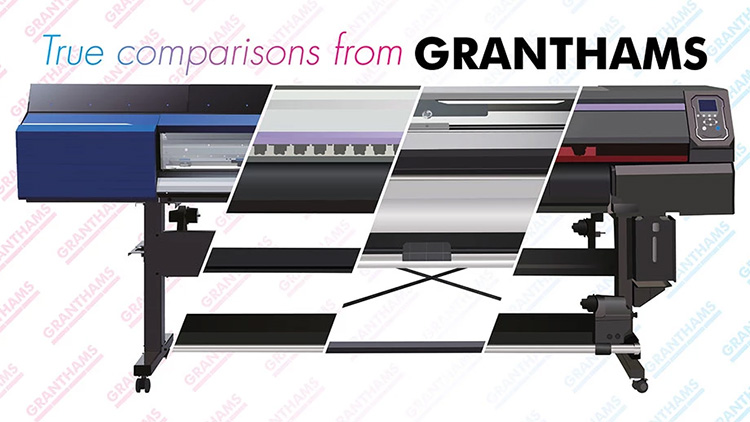Given Granthams credentials as a reputable reseller for Latex, UV and Solvent printers from all of HP, Mimaki and Roland DG, who better to give you an impartial overview?
No sales pitch, just a useful insight in to the knowledge gathered over the many years that Granthams have spent discussing various wide-format print options with their customers.
Below they have simplified some of the benefits and negatives of each system, which will hopefully help you to make sense of which solution might best match your particular application and print production requirements.
Solvent - Wide-Format Digital Print Technology that uses Solvent Inks
Solvent technology has been around for years. In fact, after the aqueous (water-based inks primarily for indoor use) printers, solvent was the next leap forward and the first ink sets truly designed for the easy production of long-lasting durable print for outdoor applications.
These requirements still remain the same today and most manufacturer’s inks are well into their second and third generations. Constantly improving, solvent inks are renowned for their wide colour gamut, vibrancy and quality. White ink has also been developed for solvent.
Solvent inks are designed to penetrate the media and bind with the print substrate. The way the ink keys to a vinyl is why it maintains the ‘stretch’ - perfect for vehicle wrapping when partnered with a cast vinyl.
On gloss media solvent print remains glossy and on a matte finish they stay flat.
The negatives of solvent printing come down to the odour and the need for solvent ink to ‘gas off’.
The odour has got less and less noticeable with each ink formulation update but compared to both UV and latex, there is still a solvent smell.
‘Gassing off’ is the evaporation of the solvents within the ink carrier and how these solvents dissipate away from the print media.
This release needs to be unhindered and usually takes 12 or so hours (the new Roland VG2 has reduced it to 6 hours). It means that if the job needs to be laminated, it can put an extra day on production.
UV Curable - Wide-Format Digital Print Technology that uses UV Curable Inks
UV technology uses an ultra-violet light unit to instantly cure the ink on to the print substrate.
It creates a strong bond and because of how it works, it’s currently a popular choice when it comes to flatbed direct printing.
As soon as the UV lamp passes over the printed UV inks, the inks cures instantly. There is only minimal heat from the lamp meaning no potential vinyl shrink issues.
No odour, no need to ‘gas off’, and with more cost-effective white ink options, UV technology has steadily grown in popularity for roll-to-roll machines designed to produce window graphics and decals.
The only downsides are that UV inks can look slightly less vibrant when compared to solvent. They also don’t stretch quite as much as solvent inks so for vehicle wraps, UV may not be the best option.
UV ink also sits on the surface of the substrate which means it can leave a consistent matte finish. By sitting on the top, they create a slight uneven finish depending on ink levels and this can mean high-coat weight laminates are needed when finishing.
Latex - Wide-Format Digital Print Technology that uses Latex Inks
Like UV, latex inks instantly cure. They were first developed by HP and use a similar water-based technology that became synonymous with Hewlett Packard for over two decades.
With lower running costs than solvent, latex has proved itself as something of an economical workhorse within the print industry over the last 10 years.
No odour, instant dry and again no need to ‘gas off’, prints from a latex can be finished and laminated as soon as they are off the machine.
In today’s environmentally conscious times, latex ink’s water-based tech has acknowledged green credentials where the other systems do not.
The colour vibrancy of latex is not quite up there with solvent - it is more similar to UV - and there isn’t quite the amount of stretch of solvent when used on cast vinyl.
The machines do require more heat to cure the water-based inks and with latex there is currently no white ink option.
If stickers and decals are part of your business, there are no integrated print and cut* latex machines.
With HP’s latex solution deriving from the revolutionary HP5000, it uses the same familiar principal of plug and play printhead replacement with built-in quality and performance checking that makes daily maintenance a simple, automated task.
In summary and getting more help
We hope the above helps, but of course there may be other reasons why your business would benefit more from one print technology over another - you are invited to contact Granthams for answers to your specific questions
As well as individual one on one help, Granthams can provide you with free samples produced on each of the above print technologies - contact them directly:
Granthams Ltd are online at www.granthams.co.uk, you can also phone them on 01772 250207 or fire an email over to sales@granthams.co.uk
*Another future Blog from Granthams will look at whether separate printing and cutting machines are best for your production, or whether integrated all-in-one print and cut devices are preferable.





